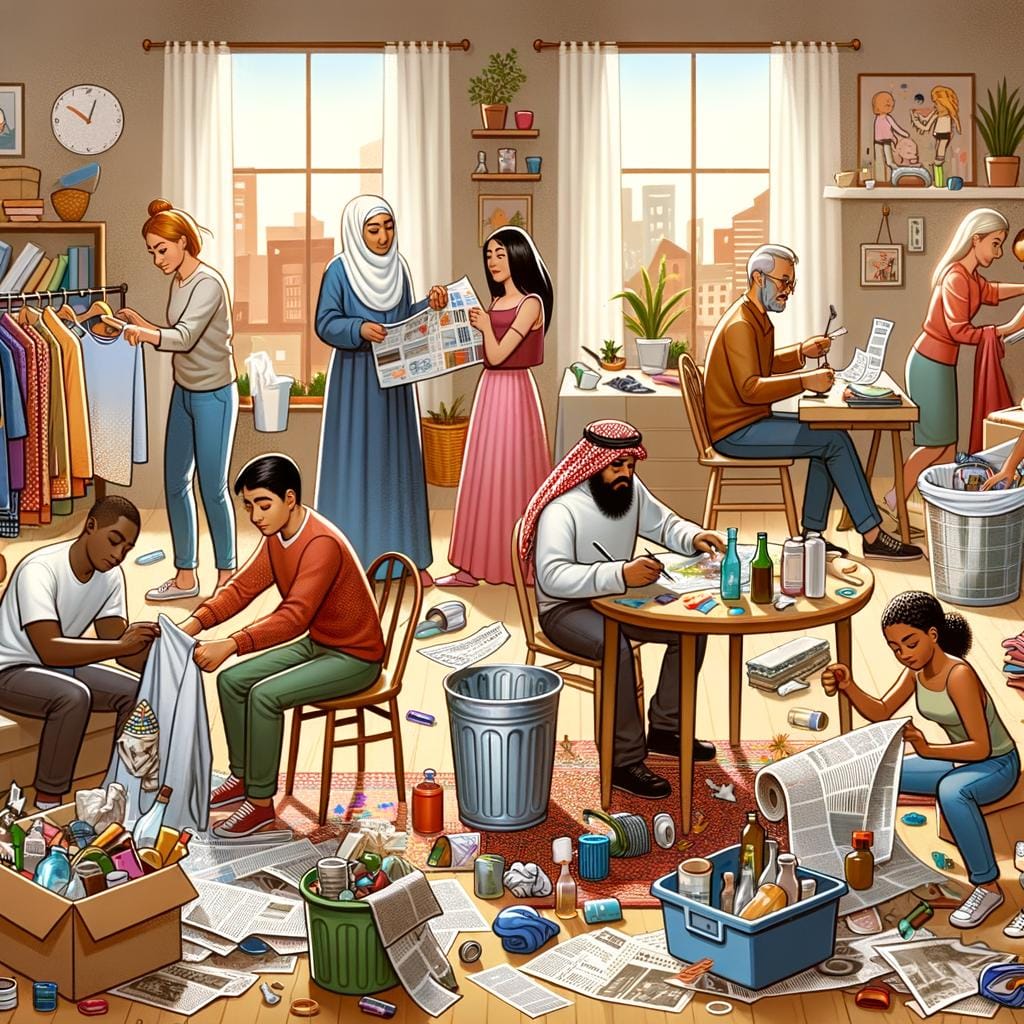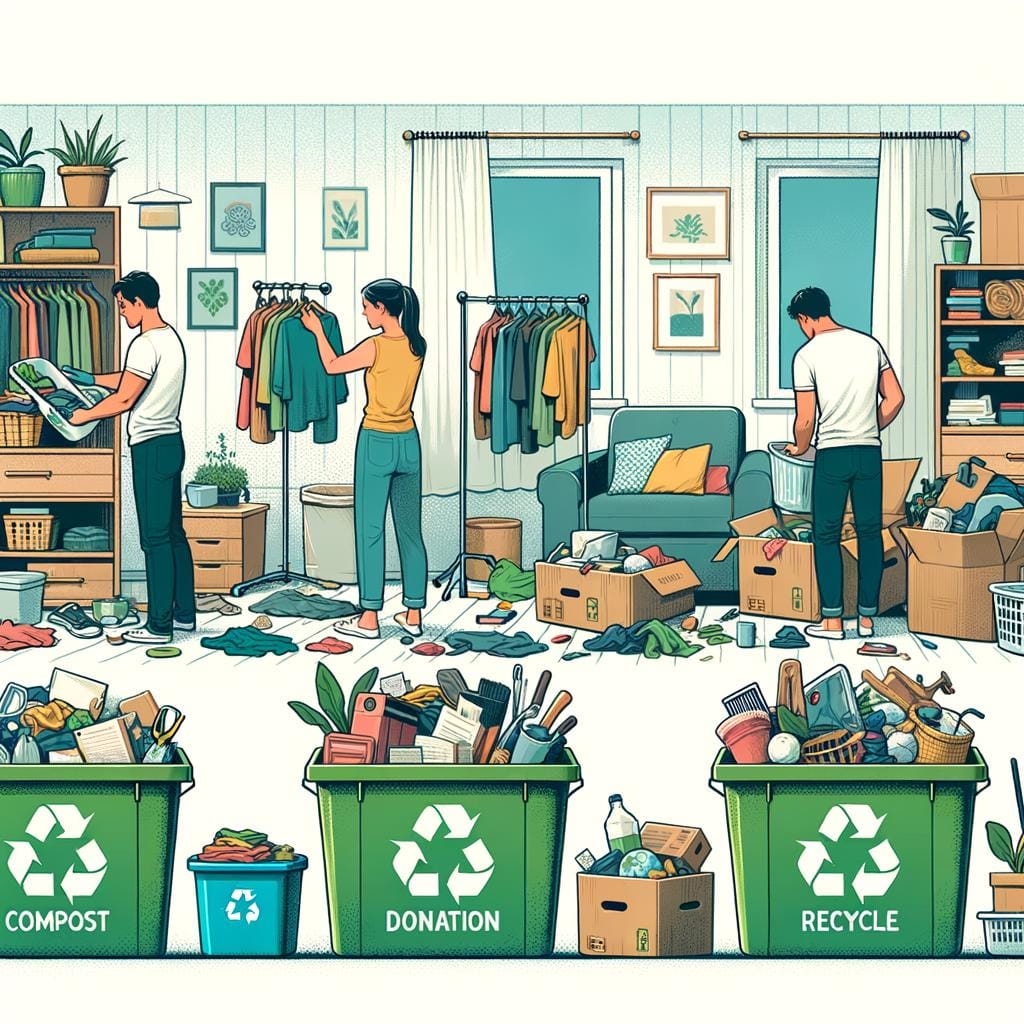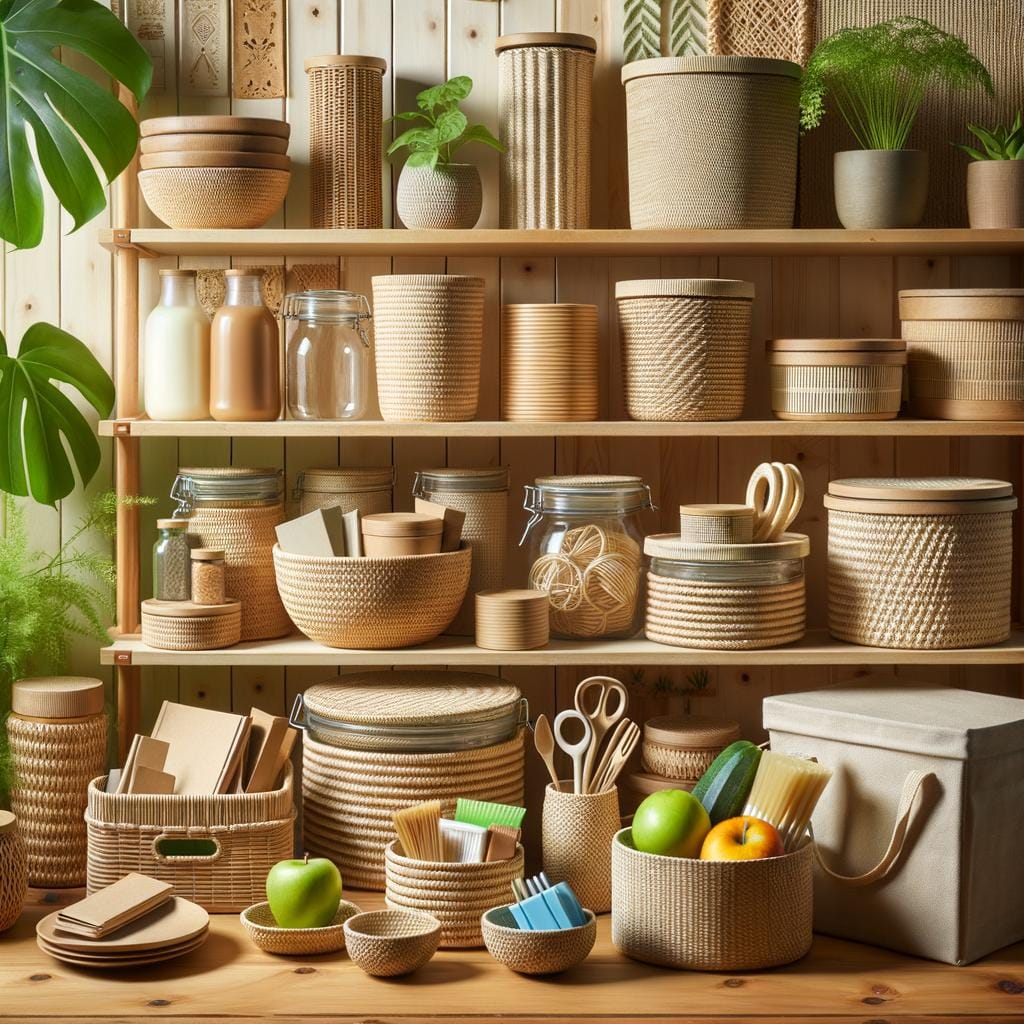In today’s world where sustainability and environmental consciousness are at the forefront, waste reduction during decluttering has become a crucial aspect of creating a greener lifestyle. Decluttering not only helps create a more organized living space but also provides an opportunity to reduce waste and minimize our impact on the environment. By incorporating practices that focus on waste reduction during the decluttering process, individuals can contribute to a more sustainable way of living while simplifying their surroundings.
The accumulation of excessive belongings not only clutters our physical space but also has detrimental effects on the environment. From textiles to electronics, every item we own consumes resources during production and adds to landfill waste when discarded.
Understanding the impacts of our possessions on the environment is essential in making conscious decisions about what we keep, donate, recycle, or dispose of during the decluttering process. By being mindful of reducing waste, we can align our actions with sustainable practices and make a positive difference in preserving our planet.
As individuals embark on the journey of decluttering their homes, practical tips can be instrumental in effectively reducing waste. Sorting and categorizing items for donation, recycling, or proper disposal is a foundational step towards minimizing clutter while ensuring that useful items find new homes rather than ending up in landfills.
Taking creative approaches such as repurposing or upcycling items not only prevents unnecessary waste but also showcases innovative ways to breathe new life into old belongings. Through conscious decision-making and intentional actions, waste reduction becomes an integral part of decluttering for a more environmentally-friendly lifestyle.
Understanding the Impact of Excessive Belongings on the Environment
Excessive belongings not only clutter our homes but also have a significant impact on the environment. The production, transportation, and disposal of these items contribute to carbon emissions, resource depletion, and landfill overflow. By understanding the environmental consequences of having too many possessions, individuals can be motivated to declutter responsibly and reduce waste.
To tackle the issue of excessive belongings, it is essential to start by assessing the items we own and questioning their necessity. Creating a conscious shopping habit moving forward can prevent unnecessary accumulation of goods. Additionally, opting for quality over quantity when making purchases can lead to a more sustainable lifestyle and minimize waste in the long run.
To further reduce waste during decluttering, individuals can follow these practical tips:
- Make a plan: Set realistic goals and allocate time for decluttering specific areas of your home.
- Sort and categorize items: Create designated piles for donation, recycling, selling, or disposal.
– Organize a swap party with friends or family members to exchange gently used items instead of buying new ones.
By implementing these strategies, one can make a positive impact on both their living space and the environment by reducing waste during decluttering.
Practical Tips for Starting the Decluttering Process
Decluttering your living space is not just about organizing your belongings; it’s also an opportunity to reduce waste and contribute to a more environmentally friendly lifestyle. To start the decluttering process with waste reduction in mind, consider the following practical tips:
- Set specific goals: Begin by identifying areas in your home that need decluttering and set realistic goals for each space. Whether it’s clearing out your wardrobe or sorting through old paperwork, having specific objectives will help you stay focused and efficient.
- Start small: Tackling a massive decluttering project can be overwhelming, so start with a smaller area like a drawer or closet. Breaking down the process into manageable tasks not only makes it less daunting but also allows you to see progress more quickly.
- Use the “4-box” method: When going through your belongings, use four boxes labeled “Donate,” “Recycle,” “Sell,” and “Trash.” This method helps you categorize items as you go along, making it easier to decide what to keep and what to discard.
By incorporating these practical tips into your decluttering routine, you can not only create a more organized living environment but also contribute to waste reduction during the process. Remember that every small step counts towards a greener and more sustainable lifestyle.
Remember, decluttering is not just about getting rid of stuff – it’s also an opportunity to make conscious choices about how we handle our belongings and their impact on the environment. So next time you embark on a decluttering project, keep waste reduction in mind and utilize these practical tips to make a positive difference.
Incorporating waste reduction practices into your decluttering routine is not only beneficial for the environment but also for creating a more mindful consumption habit. By starting small, setting specific goals, and using efficient sorting methods, you can streamline the decluttering process while minimizing waste generation. So let’s commit to reducing waste during decluttering for a cleaner, greener future.
How to Properly Sort and Categorize Items for Donation, Recycling, or Disposal
When embarking on a decluttering journey, one of the crucial aspects to consider is the responsible handling of items that are no longer needed. Properly sorting and categorizing belongings for donation, recycling, or disposal can significantly contribute to waste reduction during decluttering. By implementing effective strategies for managing unwanted items, individuals can make a positive impact on the environment while decluttering their spaces.
Assessing Items for Donation
When sorting through your possessions, it is essential to evaluate whether certain items can be donated rather than discarded. Clothing, furniture, household goods, and electronics in good condition are often accepted by charitable organizations or thrift stores.
Make a pile of items that can benefit others through donation and set them aside for collection or drop-off at designated centers. Remember that donating gently used items not only helps those in need but also reduces the amount of waste sent to landfills.
Implementing Effective Recycling Practices
For items that cannot be donated due to wear and tear or damage, recycling is an ideal option to divert them from ending up in the landfill. Identify recyclable materials such as paper, cardboard, plastics, glass, and metals among your belongings. Separate these items into designated bins or containers for recycling collection. Research local recycling facilities or programs that accept specific materials for proper processing. By recycling eligible items during decluttering, you can contribute to resource conservation and energy savings.
Disposing of Unsalvageable Items Responsibly
Some items may no longer have any practical use or are beyond repair, making disposal necessary. When discarding such belongings, it is crucial to follow environmentally-friendly practices to minimize the impact on the planet. Be mindful of hazardous substances like chemicals, batteries, or electronic waste that require special handling procedures.
Consult with local waste management authorities or disposal services for guidance on safely disposing of these materials. By incorporating responsible disposal methods into your decluttering process, you can prioritize waste reduction and promote sustainability in your home environment.
Creative Ways to Repurpose or Upcycle Items Instead of Throwing Them Away
Repurposing or Upcycling Furniture
One of the most creative ways to reduce waste during decluttering is to repurpose or upcycle furniture. Instead of discarding old or worn-out pieces, consider giving them a new lease on life with a fresh coat of paint, new hardware, or even a complete makeover.
You can turn an old dresser into a stylish kitchen island, transform wooden pallets into chic outdoor furniture, or repurpose an antique trunk into a trendy coffee table. Not only will this save these items from ending up in the landfill, but it will also add unique and personalized touches to your living space.
DIY Home Decor Projects
Another fantastic way to minimize waste during decluttering is by getting creative with DIY home decor projects. Rather than throwing away old glass jars, tin cans, or wine bottles, consider turning them into charming vases, candle holders, or organizers.
You can also repurpose fabric scraps into colorful throw pillows, old picture frames into shabby chic trays, or mismatched plates into a stunning mosaic art piece. Embracing your inner artist and using materials you already have at hand not only reduces waste but also adds character and charm to your home.
Repurposing Clothing and Textiles
When decluttering your wardrobe and linen closet, don’t rush to toss out unwanted clothing and textiles. Instead of contributing to textile waste in landfills, consider repurposing them into new garments or household items. Old t-shirts can be transformed into reusable shopping bags or cleaning rags, while worn-out towels can be repurposed as eco-friendly cleaning cloths.
You can even upcycle old jeans into trendy denim skirts or jackets for a fashionable and sustainable wardrobe update. By thinking creatively about how to breathe new life into discarded textiles, you can reduce waste while adding unique pieces to your daily life.
The Benefits of Selling Unwanted Items or Hosting a Yard Sale
Selling unwanted items or hosting a yard sale can be a great way to reduce waste during the decluttering process. Instead of simply throwing away items that you no longer need, selling them allows for someone else to give them a new life. This not only reduces the amount of waste ending up in landfills but also promotes a more sustainable approach to consuming goods.
Hosting a yard sale can also be a fun and social event where neighbors, friends, and community members can come together to shop for affordable goods. By taking part in this activity, you are not only reducing waste but also contributing to the local economy and fostering connections within your community. Additionally, the extra cash earned from selling items can be put towards environmentally-friendly purchases or activities.
When preparing for a yard sale, it is important to properly advertise the event through social media, local flyers, and word-of-mouth to attract as many visitors as possible. Organizing items neatly and pricing them appropriately will also help ensure a successful sale. By putting effort into selling unwanted items rather than simply discarding them, you are actively participating in waste reduction during decluttering while benefiting both yourself and the environment.
Utilizing Local Recycling and Donation Centers for Sustainable Waste Management
When it comes to decluttering our homes, one crucial aspect that often gets overlooked is waste reduction during the process. The amount of items we discard can have a significant impact on the environment if not handled properly. By utilizing local recycling and donation centers, we can ensure that our unwanted belongings are disposed of in an environmentally responsible manner.
Local recycling centers play a vital role in waste reduction during decluttering by providing facilities where items like paper, plastic, glass, and electronics can be properly recycled. This helps prevent these materials from ending up in landfills, where they can take years to decompose and release harmful toxins into the environment.
Donation centers, on the other hand, offer a sustainable solution for items that are still in good condition but no longer needed. By donating these items, we not only extend their lifespan but also reduce the demand for new products and raw materials.
In addition to reducing waste during decluttering, utilizing local recycling and donation centers can also benefit the community by supporting charitable organizations and creating opportunities for those in need. It’s a win-win situation that promotes sustainability while giving back to those less fortunate. By making use of these resources, we can contribute to a greener and more sustainable lifestyle while decluttering our living spaces effectively.
| Benefit | Support |
|---|---|
| Proper recycling | Local recycling centers |
| Extend product life | Donation centers |
| Support charity | Community organizations |
Eco-Friendly Storage Solutions to Prevent Future Clutter and Waste Accumulation
When it comes to decluttering, one of the key aspects to consider for long-term success is implementing eco-friendly storage solutions. These solutions not only help in organizing your belongings effectively but also contribute to waste reduction during decluttering. By investing in sustainable storage options, you can minimize the need for excessive consumption and disposal of items, leading to a more environmentally friendly approach to managing your possessions.
One practical eco-friendly storage solution is using containers made from recycled materials. Whether it’s bins, baskets, or boxes, opting for storage containers that are repurposed from materials like cardboard, bamboo, or even recycled plastic can significantly reduce the environmental impact of your organization efforts. In addition to reducing waste, these containers are often durable and versatile, providing a functional and sustainable storage option for various items in your home.
Another eco-conscious storage solution is incorporating furniture pieces that serve a dual purpose of storage and style. For instance, choosing multifunctional pieces like ottomans with hidden compartments, coffee tables with built-in storage shelves, or bed frames with under-bed drawers can help maximize space while minimizing clutter. These furniture items not only offer innovative storage solutions but also promote resourcefulness by making the most out of every piece of furniture in your living space.
Lastly, embracing the concept of upcycling when creating DIY storage solutions can further aid in waste reduction during decluttering. By repurposing old or unused items into unique storage pieces such as shelves made from wooden crates, hanging organizers from fabric scraps, or jewelry holders from vintage frames, you can transform waste into functional and visually appealing organizational tools.
Upcycling not only adds a personalized touch to your living environment but also reduces the amount of discarded materials that end up in landfills.
| Storage Solutions | Benefits |
|---|---|
| Containers made from recycled materials | Reduce environmental impact and provide durable organization options |
| Multifunctional furniture pieces | Maximize space utilization while adding style and reducing clutter |
| Upcycled DIY storage solutions | Transform waste into functional organizational tools with a personalized touch |
Conclusion
In conclusion, the process of decluttering goes beyond just organizing and tidying up our living spaces; it presents a valuable opportunity to contribute towards waste reduction and environmental sustainability. By being mindful of what we discard during decluttering, we can make a positive impact on the environment and reduce our carbon footprint. This shift in mindset not only benefits the planet but also promotes a more sustainable lifestyle for ourselves and future generations.
It is crucial to recognize the impact of excessive belongings on the environment, as the accumulation of unused or unwanted items can lead to unnecessary waste generation. Therefore, implementing practical tips for starting the decluttering process, such as categorizing items for donation, recycling, or proper disposal, becomes essential in minimizing our contribution to landfills and promoting a circular economy.
By consciously choosing to repurpose or upcycle items instead of throwing them away, we can breathe new life into old possessions and reduce our reliance on single-use products.
Furthermore, embracing eco-friendly storage solutions and utilizing local recycling and donation centers are key strategies in maintaining a clutter-free environment while supporting sustainable waste management practices. Selling unwanted items or hosting yard sales not only declutters our spaces but also gives others the opportunity to repurpose preloved goods. In essence, making waste reduction a priority during decluttering not only enhances our living spaces but also fosters a greener lifestyle that aligns with conservation efforts for a healthier planet.
Frequently Asked Questions
How Do You Declutter Without Being Wasteful?
When decluttering without being wasteful, it’s important to carefully assess the items you no longer need. Consider donating them to charitable organizations, hosting a garage sale, or even upcycling them into something useful. Recycling any items that are not suitable for donation is also a great way to reduce waste during the decluttering process.
What Is an Example of Waste Reduction?
An example of waste reduction is minimizing single-use plastics in your daily life. This can include using reusable bags, water bottles, and containers instead of disposable ones. By opting for products that can be used multiple times, you are contributing to reducing the amount of waste generated and ultimately helping the environment.
What Should You Not Throw Out When Decluttering?
When decluttering, avoid throwing out items that still have value or could be repurposed in some way. For example, old furniture can be refurbished or given a new look with a fresh coat of paint.
Clothes that no longer fit can be donated to those in need or even used as cleaning rags. By thinking creatively about how to reuse or recycle items before tossing them out, you can minimize unnecessary waste during the decluttering process.

Hello, I’m April Denton, your go-to expert for all things home decluttering and organization. With over a decade of experience helping individuals transform their living spaces into serene, clutter-free sanctuaries, I am passionate about the life-changing benefits of decluttering. My journey into the world of organization began out of necessity, juggling a busy career and a bustling household. I quickly realized that a well-organized home was the key to a more balanced, stress-free life.





